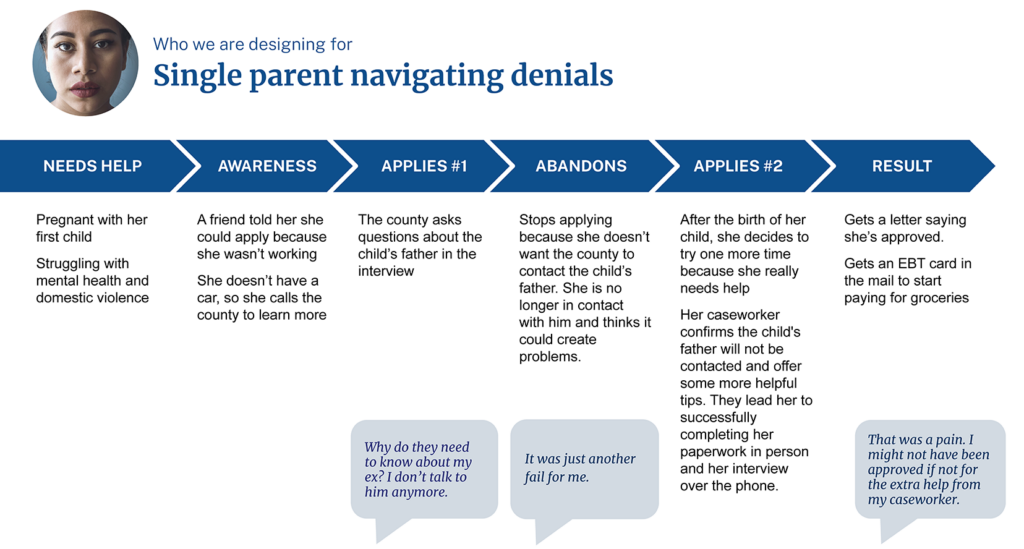
Our research found root problems that keep Californians from enrolling in a key program.
Project scope
- Timeline: 8 weeks
- Team: 2 user researchers, 1 researcher/data analyst, 1 UX designer, 1 visual designer, 1 content designer, 1 product manager
- Reach: 35 Californians including applicants, enrollees, county staff, community-based organizations, and state subject-matter experts
Partners
Methods
- User experience research
- User interviews
- Data analytics
- Journey mapping
- Content design
- Desk research
Needs
California Work Opportunity and Responsibility to Kids (CalWORKs) is a critical safety net program overseen by the California Department of Social Services (CDSS). It provides temporary cash aid and services to eligible families with children. California families rely on this program to help pay for necessary expenses like housing, food, and child care.
But in a recent study, the Legislative Analyst’s Office (LAO) found an estimated 40% of families eligible for CalWORKs were not enrolled. CDSS reached out to the Office of Data and Innovation (ODI) to explore the barriers for eligible families to enroll in CalWORKs.
Approach
In fall 2022, ODI and CDSS began an 8-week discovery sprint. Because CalWORKs is overseen by the state but operated by counties, we first started by mapping the diverse stakeholder and partner landscape. We then assessed enrollment data across the state and looked at the tools used to administer the program.
The core of our research was conducting interviews with 35 Californians to learn about their experiences with the program and application process. We engaged with:
- Applicants who were recently approved, denied, or did not complete the process
- Current and former program enrollees
- Staff from county social services offices in different regions across the state
- Community-based organizations who support applicants and enrollees
- Subject matter experts at the state
Tools
We created tools that center the applicant and county staff experiences to present a clear vision of needs for CDSS and its partners.
- User journey maps: Outlined scenarios to show what might get in the way of successfully applying and used quotes to highlight the lived experience of applicants.
- Improvement project roadmap: Visual representation of all current CalWORKs improvement efforts and how they address the needs identified in the journey maps.
- Policy review: A prioritized list of policies and requirements that affect the applicant experience.
Spotlight: user journey map
The sample user journey map below is not from a single interview, but represents common themes shared by CalWORKs applicants.

This has been a chance to understand user experience in a way we didn’t previously…this gives us a finite short list for further exploration.
—CDSS employee
Insights
The results of our research challenge the initial assumption that the root cause of the 40% uptake gap was a lack of program awareness. We found instead that:
Reduced burdens will improve enrollment and retention
Many eligible families weren’t enrolling because the application process was too overwhelming. We also learned that many families struggled to maintain enrollment due to similar challenges with the process.
Burdens to applicants and enrollees are also burdens to county staff
Sticking points in the application and review processes are hard from all perspectives, so we identified recommendations that would benefit all involved.
Communication to applicants and enrollees needs to be more clear, timely, and streamlined
Language in paper notices and online portals should be simplified for easier comprehension. Automating messages and confirmations would streamline the process for applicants and staff.
Simpler policy guidance to counties would ease administrative burden
Guidance to counties is complex and hard to understand. Simplifying it would help counties more efficiently implement policy changes.
Impact
CDSS empowered to communicate the vision for the CalWORKs program
CDSS is using the tools from this effort with program partners to establish a cohesive vision for moving forward with all program improvements. For example, CDSS is investigating the Policy Review with partners to determine what can be changed to remove unnecessary burdens.
CDSS has actionable recommendations to prioritize next steps
With a distilled list of recommendations, CDSS now has a clear path to reduce burdens for applicants and streamline processes for counties.
Since completing this project, CDSS has taken ODI’s recommendations framework and begun prioritizing with partners and stakeholders.
Data and Innovation Fund
This project was part of the Data and Innovation Fund (DIF), one way the Office of Data and Innovation (ODI) helps improve state services for all Californians. ODI works in partnership with the California Department of Technology (CDT), which improves state technology infrastructure through its Technology Modernization Fund (TMF) and Technology Stabilization Service (TSF). Together, these three funds ensure California state departments innovate by applying human-centered design, data, and IT investments to yield quick and meaningful results.
Email info@innovation.ca.gov to learn more about this project.